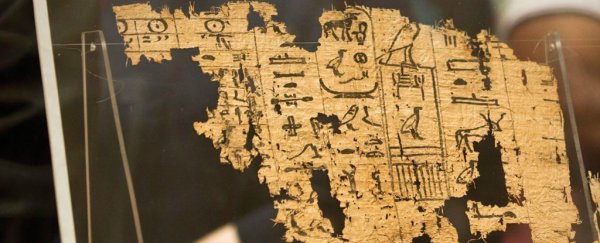Archaeologists in Egypt have recently unveiled a series of 4,500-year-old papyri that they say are the oldest writings ever found in the region.
While this news is awesome by itself, the contents of the documents make the find even better, because they detail the daily lives of the workers who built the Great Pyramid under the reign of Pharaoh Khufu (2589 BC to 2566 BC).
The documents were originally found back in 2013 inside a series of caves near Wadi al-Jarf – an ancient port on the Red Sea – by Egyptologists Pierre Tallet and Sayed Mahfouz.
Until now, no one has really gotten a chance to look at the papyri, but six of the 30 pages will go on display at the Egyptian Museum in Cairo.
For Egyptologists, the papyri are a gold mine of information about how ancient Egypt was governed and how the Great Pyramid was built. In fact, most of the documents are from Khufu's accounting department, which was tasked with keeping track of all the goods moving through his kingdom.
"The documents indicate the highly efficient administrative system in Khufu's reign," said Egypt's ministry of Antiquities.
Besides detailing how much workers were paid and how their wages were given out (two facts that the team doesn't go into detail about), it also gives first-hand accounts from the workers who helped build the Great Pyramid, one of the most fascinating and mysterious structures in existence.
"One of the papyri belonged to a senior employee named Marr who played a role in the building of the pyramid and it covered a period of three months of his job, providing information about his duties – including transporting rocks through the River Nile and its canals," said ministry official Hussein Abdel-Bassir, according to an AP report.
Though the documents have been in the possession of Egypt's Antiquities Ministry since their discovery, officials have just now decided to put them on display in the Egyptian Museum so the public can get a chance to see one of the oldest pieces of writing ever found.
"These discoveries should not be hidden in boxes. We need to attract the attention of the whole world to Egypt; that is why I decided to showcase the papyri because such relics will revive tourism in Egypt," said museum curator Sabah Abdel-Razek.
The papyri announcement comes at a time when researchers are seemingly finding new things out about the Great Pyramid on a monthly basis.
For example, back in June, researchers from the US found out that the pyramid is actually lopsided due to an error made during early construction.
Also, just last week, The Science Channel's series Unearthed recreated a primitive security system used inside the pyramid that was supposed to keep would-be tomb raiders from pilfering the remains of Khufu, though no one knows if the system truly failed or not because it's possible that Khufu's remains haven't been found yet (cue the mysterious music).
Needless to say, it's a very exciting time to be an Egyptologist (or a fan of archaeology in general).
Hopefully, as scanning equipment becomes better and better, we will one day unravel all of the pyramids mysteries, but until then at least we have some cool new documents to look over.
